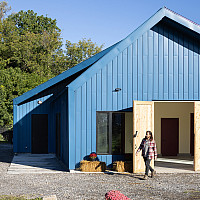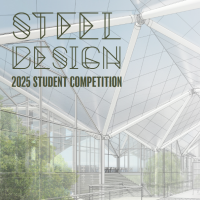In the United States, most registration boards require a degree from an accredited professional degree program as a prerequisite for licensure. The National Architectural Accrediting Board (NAAB), which is the sole agency authorized to accredit professional degree programs in architecture offered by institutions with U.S. regional accreditation, recognizes three types of degrees: the Bachelor of Architecture, the Master of Architecture, and the Doctor of Architecture. A program may be granted an eight-year term, an eight-year term with conditions, or accreditation, or a three-year term of initial accreditation, depending on the extent of its conformance with established education standards. Doctor of Architecture and Master of Architecture degree programs may require a non-accredited undergraduate degree in architecture for admission. However, the non-accredited degree is not, by itself, recognized as an accredited degree.
Syracuse University School of Architecture offers the following NAAB-accredited degree programs:
B.Arch: 157 credits; M.Arch 92 credits
Next NAAB Accreditation Visit: 2025
NAAB Conditions and Procedures for Accreditation (Current and Historic)
Shared Values of the Discipline and Profession
The program must report on how it responds to the following values, all of which affect the education and development of architects. The response to each value must also identify how the program will continue to address these values as part of its long-range planning. These values are foundational, not exhaustive.
Design: Architects design better, safer, more equitable, resilient, and sustainable built environments. Design thinking and integrated design solutions are hallmarks of architecture education, the discipline, and the profession.
Environmental Stewardship and Professional Responsibility: Architects are responsible for the impact of their work on the natural world and on public health, safety, and welfare. As professionals and designers of the built environment, we embrace these responsibilities and act ethically to accomplish them.
Equity, Diversity, and Inclusion: Architects commit to equity and inclusion in the environments we design, the policies we adopt, the words we speak, the actions we take, and the respectful learning, teaching, and working environments we create. Architects seek fairness, diversity, and social justice in the profession and in society and support a range of pathways for students seeking access to an architecture education.
Knowledge and Innovation: Architects create and disseminate knowledge focused on design and the built environment in response to ever-changing conditions. New knowledge advances architecture as a cultural force, drives innovation, and prompts the continuous improvement of the discipline.
Leadership, Collaboration, and Community Engagement: Architects practice design as a collaborative, inclusive, creative, and empathetic enterprise with other disciplines, the communities we serve, and the clients for whom we work.
Lifelong Learning: Architects value educational breadth and depth, including a thorough understanding of the discipline’s body of knowledge, histories and theories, and architecture’s role in cultural, social, environmental, economic, and built contexts. The practice of architecture demands lifelong learning, which is a shared responsibility between academic and practice settings.
Program and Student Criteria
These criteria seek to evaluate the outcomes of architecture programs and student work within their unique institutional, regional, national, international, and professional contexts, while encouraging innovative approaches to architecture education and professional preparation.
3.1 Program Criteria (PC) A program must demonstrate how its curriculum, structure, and other experiences address the following criteria.
PC.1 Career Paths—How the program ensures that students understand the paths to becoming licensed as an architect in the United States and the range of available career opportunities that utilize the discipline’s skills and knowledge.
PC.2 Design—How the program instills in students the role of the design process in shaping the built environment and conveys the methods by which design processes integrate multiple factors, in different settings and scales of development, from buildings to cities.
PC.3 Ecological Knowledge and Responsibility—How the program instills in students a holistic understanding of the dynamic between built and natural environments, enabling future architects to mitigate climate change responsibly by leveraging ecological, advanced building performance, adaptation, and resilience principles in their work and advocacy activities.
PC.4 History and Theory—How the program ensures that students understand the histories and theories of architecture and urbanism, framed by diverse social, cultural, economic, and political forces, nationally and globally.
PC.5 Research and Innovation—How the program prepares students to engage and participate in architectural research to test and evaluate innovations in the field.
PC.6 Leadership and Collaboration—How the program ensures that students understand approaches to leadership in multidisciplinary teams, diverse stakeholder constituents, and dynamic physical and social contexts, and learn how to apply effective collaboration skills to solve complex problems.
PC.7 Learning and Teaching Culture—How the program fosters and ensures a positive and respectful environment that encourages optimism, respect, sharing, engagement, and innovation among its faculty, students, administration, and staff.
PC.8 Social Equity and Inclusion—How the program furthers and deepens students’ understanding of diverse cultural and social contexts and helps them translate that understanding into built environments that equitably support and include people of different backgrounds, resources, and abilities.
Student Criteria (SC): Student Learning Objectives and Outcomes
A program must demonstrate how it addresses the following criteria through program curricula and other experiences, with an emphasis on the articulation of learning objectives and assessment.
SC.1 Health, Safety, and Welfare in the Built Environment—How the program ensures that students understand the impact of the built environment on human health, safety, and welfare at multiple scales, from buildings to cities.
SC.2 Professional Practice—How the program ensures that students understand professional ethics, the regulatory requirements, the fundamental business processes relevant to architecture practice in the United States, and the forces influencing change in these subjects.
SC.3 Regulatory Context—How the program ensures that students understand the fundamental principles of life safety, land use, and current laws and regulations that apply to buildings and sites in the United States, and the evaluative process architects use to comply with those laws and regulations as part of a project.
SC.4 Technical Knowledge—How the program ensures that students understand the established and emerging systems, technologies, and assemblies of building construction, and the methods and criteria architects use to assess those technologies against the design, economics, and performance objectives of projects.
SC.5 Design Synthesis—How the program ensures that students develop the ability to make design decisions within architectural projects while demonstrating synthesis of user requirements, regulatory requirements, site conditions, and accessible design, and consideration of the measurable environmental impacts of their design decisions.
SC.6 Building Integration—How the program ensures that students develop the ability to make design decisions within architectural projects while demonstrating integration of building envelope systems and assemblies, structural systems, environmental control systems, life safety systems, and the measurable outcomes of building performance.











